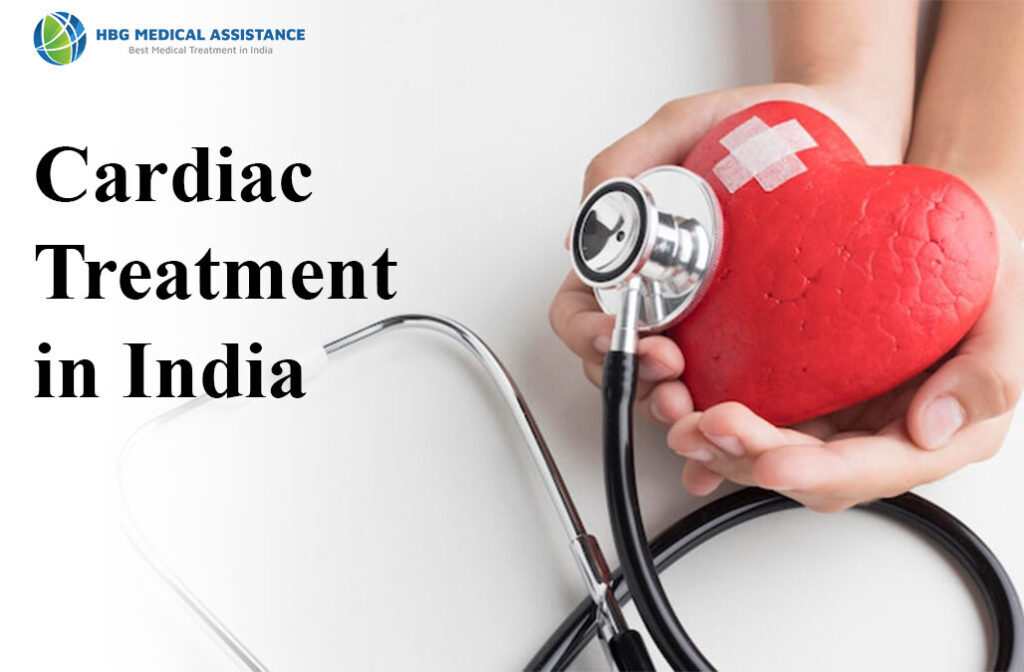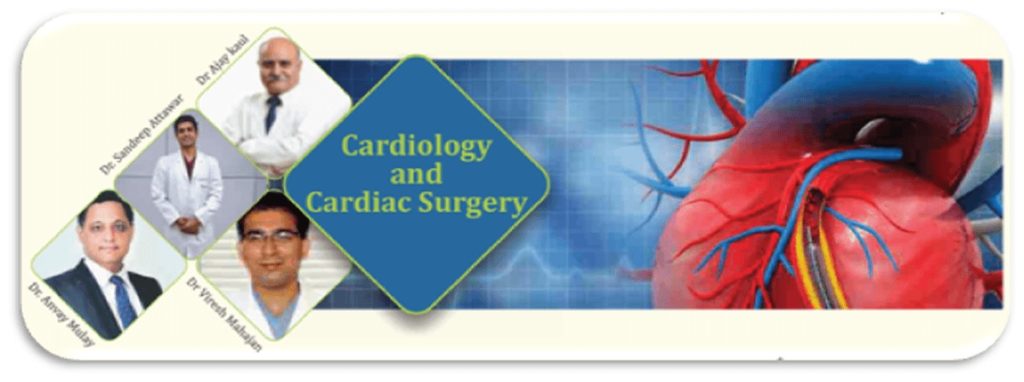
HBG Medical Assistance from the past few years has been playing an important role in arranging Cardiology Treatments in India. HBG in association with the top-notch institutions of India provides cardiac treatments and surgery for each patient in accordance with all international norms and standards. HBG’s associated hospitals in India are absolutely identical to the level of the European standard and carry quality certificates by JCI, NIAHO, NABH, and ISO; however, our prices are below 2-5-7 times. HBG’s associated hospitals are not only equipped with the latest technology, but also have a team of world-class cardiac surgeons who possess all the traditional, modern, and innovative methods of diagnosis and treatment. In most cases, the leaders of every surgical team trained and worked for a long time in the US, Western Europe, and Australia, as well as qualified to work both abroad and in India.

HBG Medical Assistance is India’s most popular medical assistance company. It is accredited by NABH (National Accreditation Board for Hospitals and Health Care Providers) which is equivalent to JCI (Joint commissioner international) in this part of the world. It is the best accreditation in Healthcare which any healthcare delivery company can get.
HBG has some wonderful offing in Heart Care. Heart treatment can be categorized depending upon the age of the patient or disease type. There is some heart disease that people are born with. These are called congenital heart defects. Sometimes these congenital heart defects are detected at an early age and we can treat them early by doing heart surgery. Sometimes these congenital heart defects are not detected and are revealed when a person grows up. We can still treat them by offering the patient heart surgery.
Sometimes heart disease is acquired depending upon a lifestyle that a person acquires as he grows up or due to environmental factors or other diseases that a patient may have. Such diseases that are acquired when a patient has grown up are called Adult Cardiac Diseases. They may be treated surgically which are called Open Heart surgeries or with help of Catheter driven procedures which are called Percutaneous Procedures. Many times Open heart surgeries are done via small incisions. These are called endoscopic heart surgeries or minimally invasive heart surgeries.
When a patient is treated at a young age, it is called Paediatric Heart Surgery. The diseases that can be treated at a young age are Heart Holes such as Atrial Septal Defect (ASD) or a Ventricular Septal Defect (VSD), a PDA or patent Ductus, A TOF or Tetralogy of Fallot or a Valve Repair or Valve Replacement. All such surgeries are called Paediatric Cardiac Surgeries. The surgeries which are offered to adults are CABG or Coronary Heart Bypass Grafting or Open-heart Bypass Surgery, Valve Replacement surgery, stenting procedures or PTCA or Percutaneous Coronary Angioplasty or treatment for Aorta. Sometimes even heart holes are treated once a person has grown up.
The aorta is the largest artery that stems from the heart and branches into smaller arteries to distribute oxygenated blood to all parts of the body. It can be divided into the ascending aorta (the part that rises from the heart), aortic arch (the part that bends over the heart), descending thoracic aorta (the part that moves down the chest region) and abdominal aorta (the part that begins at the diaphragm).
The Bentall procedure is a surgery performed to correct defects of the aorta. The bental procedure involves the replacement of the aortic root (base of the aorta) and valve (three flaps that ensure the one-way flow of blood from the heart to the aorta), and re-implantation of the coronary arteries (that branch out from the ascending aorta). The current and most common type of surgery is called the button Bentall surgery. The diseased part of your aorta is excised and the valve is inspected. The diseased aortic valves are removed. The coronary arteries, along with a large button of the surrounding wall of the aorta are dissected. An artificial graft that has a mechanical or bioprosthetic valve is sutured to the ends of the aorta. Two holes are created in the graft, into which the coronary artery buttons are sewn. The valve replacement may be tested by your surgeon by streaming some blood into the area and checking for any kind of leakage. Once the repair is complete, the incision is sutured and bandaged. The entire procedure of Bentall surgery is normally completed in less than 5 hours.
An abdominal aortic aneurysm is an enlarged area in the lower part of the aorta, the major blood vessel that supplies blood to the body. The aorta, about the thickness of a garden hose, runs from your heart through the center of your chest and abdomen.
Depending on the size and the rate at which your abdominal aortic aneurysm is growing, treatment may vary from Treatment
The goal of treatment is to prevent your aneurysm from rupturing. Generally, your treatment options are medical monitoring or surgery. Your doctor’s decision depends on the size of the aortic aneurysm and how fast it’s growing.
Surgery options for an abdominal aortic aneurysm may include:
The graft — a woven tube covered by a metal mesh support — is placed at the site of the aneurysm and expanded. The graft is fastened in place with the metal mesh that frequently has small hooks or pins. The graft reinforces the weakened section of the aorta to prevent rupture of the aneurysm.
Aortic root replacement surgery is a complex surgical procedure to treat dilation or aortic enlargement (aneurysm) of a section of the large blood vessel that carries blood from your heart to your vital organs (aorta). The aortic root is located near the junction of your aorta and your heart.
Doctors perform aortic root surgery to prevent an aneurysm rupture or a tear in the inner layer of the wall of the dilated aorta (aortic dissection), and to prevent the dilated aorta from stretching the attached aortic valve.
During aortic root operations, the aortic valve may be repaired or replaced, depending on its appearance. Many aortic aneurysm surgeries can be performed with minimally invasive methods. Compared to traditional surgery, minimally invasive approaches may be associated with reduced pain, less scarring, and shorter recovery time. Most aneurysms of the aortic root can be done through skin incisions of approximately 5cm, although we never compromise a patient’s safety to achieve a cosmetic result.
Surgery Options in Aortic Aneurysm Surgery
Removal of the damaged section of the aorta, while preserving the aortic valve. Since the aortic valve remains intact, anticoagulation therapy (to prevent blood clots) is not required.
Replacement of the aortic root and valve with a novel stentless biologic aortic root-valve conduit developed by surgeons in our program. This option provides patients with important advantages over the other available options.
Removal of the aorta and the aortic valve, as well as the attachment of the coronary arteries. The aortic root is then reconstructed with the aid of a cadaveric human (homograft) aorta. The use of a human replacement valve eliminates the need for anticoagulation, provides superior blood circulation (hemodynamic function), and may offer longer freedom from reoperation than animal tissue alternatives.
The aortic root is removed, including the valve. The coronary arteries are removed from the diseased aorta. The pulmonary artery including the valve is removed. This pulmonary artery conduit will then become the new aorta. A cadaveric conduit is then selected to replace the pulmonary artery. The Ross procedure is generally reserved for younger patients, as valve-sparing procedures and advanced biological conduits have largely supplanted its use in adults.
Replacement of the entire aorta root and aortic valve with a combination of a mechanical valve with an attached tube graft. Also called the modified Bentall operation, this approach is often used in younger patients or in those patients who wish to avoid reoperation. Anticoagulation therapy is required.
Coronary bypass surgery or CABG is a surgical procedure that diverts the flow of blood around a section of a blocked or partially blocked artery in your heart. By creating a new pathway to the heart, coronary bypass surgery improves blood flow to your heart muscle.
During coronary bypass surgery or CABG, a healthy blood vessel is taken from your leg, arm, or chest and connected to the other arteries in your heart so that blood bypasses the diseased or blocked area.
After coronary bypass surgery, symptoms, such as chest pain and shortness of breath due to poor blood flow to the heart, generally improve. For some people, coronary bypass surgery may improve heart function and reduce the risk of dying of heart disease.
Heart valve surgery is a procedure to treat heart valve disease. In heart valve disease, at least one of the four heart valves that keep blood flowing in the correct direction through your heart doesn’t function properly.
These valves include the mitral valve, tricuspid valve, pulmonary valve, and aortic valve. Each valve has flaps called leaflets, for the mitral and tricuspid valves, and cusps, for the aortic and pulmonary valves. These flaps open and close once during each heartbeat. Sometimes the valves don’t open or close properly, disrupting the blood flow through your heart to your body. Heart valve surgery may be needed if your condition is getting worse, your condition is severe or you’re experiencing signs and symptoms of valve dysfunction.
Biological valves often eventually need to be replaced, as they degenerate over time. If you have a mechanical valve, you’ll need to take blood-thinning medications for the rest of your life to prevent blood clots. Doctors will discuss with you the risks and benefits of each type of valve and discuss which valve may be appropriate for you.
They are made from durable metals, carbon, ceramics, and plastics. A fabric sewing ring is used to attach the valve to the tissues in the patient’s heart. The major advantage is durability. However, blood thinners must be taken for the rest of the patient’s life to prevent blood clots
A minimally invasive catheter procedure may be conducted to replace certain heart valves. For example, a catheter procedure may be performed to insert a replacement valve into a biological replacement valve in the heart that is no longer working properly




Cancer Treatment in India, VSD Closure (Ventricular Septal Defect), ASD Closure Surgery (Atrial Septal Defect), Heart hole closure surgery in india, Brain Tumour Surgery in India, Craniotomy Surgery for Treatment of Brain Tumour in India, Brain Stem Glioma Treatment in India, Deep Brain Stimulation surgery in india , Best Spine Surgery In India , Cervical Spine Disorders Surgery and Treatment in india , epilepsy surgery in india , Heart Surgery in india , Best open heart surgery hospital in India , All about Spine Surgery, Types of Back Surgery , Top Doctors In India , Best Hospitals in India , Bhavin Desai cardiac surgeon, Best kidney transplant doctor in IndiaBest hospital for limb lengthening surgery in India, Best hospital for neurosurgery in India, Best hospital for bypass surgery in India, Narayana Hrudayalaya online appointment, Best orthopedic hospital in Bangalore, Best open heart surgery hospital in India, Best bypass surgeon in India, best spine surgery hospital in India, Artemis hospital Gurgaon, KD hospital medical appointment
Limb lengthening surgery cost in India, DSA test, Diabetes treatment in India